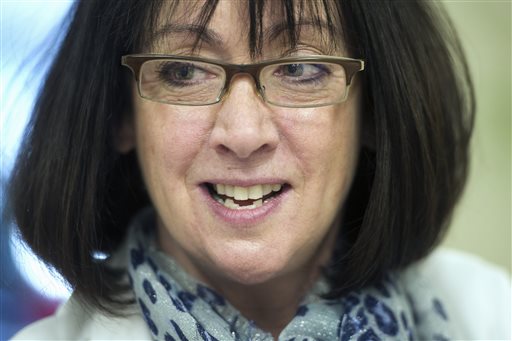
By LAURAN NEERGAARD
AP Medical Writer
WASHINGTON (AP) — It took 16 years of twists and turns. Over and over, Dr. Nancy Sullivan thought she was close to an Ebola vaccine, only to see the next experiment fail.
“A case of resuscitation more than once,” is how the National Institutes of Health researcher describes the journey.
But it is those failures that Sullivan credits for finally leading her to a vaccine promising enough to test in parts of West Africa ravaged by Ebola. Last week, volunteers in Liberia’s capital began rolling up their sleeves for the first large-scale testing of two potential Ebola vaccines, the one Sullivan developed at NIH and a similar one created by Canada’s government.
Sullivan just hopes it was in time to prove whether the shots really work.
Ebola has claimed nearly 9,000 lives in West Africa over the past year, although new infections have dropped dramatically in recent months. It’s too soon to declare victory: Last week, new cases inched up for the first time this year, and health officials fear a resurgence if they don’t completely stamp out the disease before the upcoming rainy season.
Waning cases make it more difficult to tell if a vaccine is protective, but the shots will be tested in multiple places and ways “hoping that one of those will give us real data,” said Dr. Bruce Aylward of the World Health Organization.
Getting to that step is a story of nitty-gritty laboratory science, the kind that seldom makes headlines.
“You don’t know what’s going to be important 15 years from now,” noted Sullivan, a cell biologist who kept hitting roadblocks as she tried to unravel enough mysteries of the immune system to create an Ebola vaccine.
“You need a failure to know what immune responses aren’t helpful, as difficult as they were at the time,” she said.
It all started in the late 1990s, when Sullivan, who had just earned her Ph.D. at Harvard, landed a new job at the University of Michigan. She wanted to study how Ebola infects cells, but her boss, Dr. Gary Nabel, gave her a bigger assignment: develop a vaccine capable of protecting monkeys.
Back then, the average person probably knew of Ebola only from Richard Preston’s best-seller “The Hot Zone” or the movie “Outbreak.” Discovered in 1976, the virus cropped up every few years in remote parts of Africa, killed dozens to a few hundred people with horrifying swiftness and retreated back into the jungle again. Early vaccine attempts had failed.
“The thinking was, this virus was too aggressive, it’s not possible to mount an immune response in sufficient time,” recalled Sullivan, who followed Nabel to NIH and now heads biodefense vaccine research there.
Most vaccines spur production of immune system antibodies that block a virus from entering cells, but Sullivan didn’t think that would be enough for Ebola, a large virus that infects in an unusual way.
Gene-based vaccines can induce additional virus fighters called T cells, so that’s what Sullivan created with pieces of Ebola genetic material. In July 1999, colleagues emailed that they’d given her vaccine to monkeys and measured a big immune reaction. Sullivan recently showed President Barack Obama the lab notebook where she’d scribbled her reaction: “Yahoo!”
In November 2000, Sullivan and Nabel reported in the journal Nature that four vaccinated monkeys survived an otherwise lethal dose of Ebola.
“For the first time, a vaccine protected monkeys against the lethal Ebola virus, raising doctors’ hopes of developing a means of inoculating people against the terrifying disease,” The Associated Press reported at the time.
But her vaccine required multiple shots over several months, not useful during an outbreak. Sullivan scaled back, using a human cold virus, called an adenovirus, to carry the Ebola genetic material in one shot. Then she learned it wouldn’t work in people who’ve had that particular cold virus. Using rare human adenoviruses didn’t work at all; finally a chimpanzee cold virus did the trick.
Along the way came multiple monkey studies to learn exactly what kind of T cells to target.
“Lots of shoes have dropped,” she says of all the frustration.
Sullivan had a few years’ head start but after the 2001 anthrax attack other laboratories scrambled to study Ebola and other possible bioterrorist agents. Soon after, the Public Health Agency of Canada reported creating its own Ebola vaccine using a livestock virus to carry the genetic material — the second vaccine currently being tested in that large study in Liberia.
“Thank God we had some of these” under way, said Ebola expert Thomas Geisbert of the University of Texas Medical Branch at Galveston, an early collaborator on the Canadian vaccine who helped with some of Sullivan’s initial work and now researches treatments. “You can’t do that research in six months.”
As the Liberian vaccine study gets under way, work hasn’t paused back in Sullivan’s lab. Her research in monkeys suggests long-lasting protection will require a special booster shot, something yet to begin Phase 1 safety testing in people. She goes to Congo, where Ebola first was discovered, about twice a year for research.
“It isn’t the case where you discover something and instantly move it to humans,” Sullivan wants the public to understand. “There are lots of pitfalls.”



